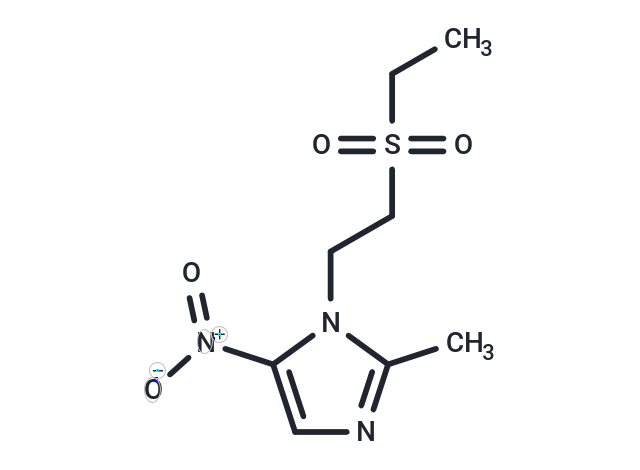Shopping Cart
- Remove All
 Your shopping cart is currently empty
Your shopping cart is currently empty

Tinidazole (CP12574)a is a 5-nitroimidazole derivative with the antiprotozoal property. Although the mechanism of action has not been fully elucidated, it has been suggested that tinidazole is metabolized and yields nitrite anions and metronidazole. Metronidazole's nitro group, in turn, is reduced via the parasite ferredoxin, thereby generating a series of free nitro radicals including nitro anions. Toxicity is achieved via depletion of sulfhydryl groups and DNA strand breaks with multiple hits having an additive effect and ultimately leading to cell death.

| Pack Size | Price | Availability | Quantity |
|---|---|---|---|
| 200 mg | $30 | In Stock | |
| 500 mg | $42 | In Stock | |
| 1 g | $56 | In Stock | |
| 5 g | $113 | In Stock | |
| 10 g | $168 | In Stock |
| Description | Tinidazole (CP12574)a is a 5-nitroimidazole derivative with the antiprotozoal property. Although the mechanism of action has not been fully elucidated, it has been suggested that tinidazole is metabolized and yields nitrite anions and metronidazole. Metronidazole's nitro group, in turn, is reduced via the parasite ferredoxin, thereby generating a series of free nitro radicals including nitro anions. Toxicity is achieved via depletion of sulfhydryl groups and DNA strand breaks with multiple hits having an additive effect and ultimately leading to cell death. |
| In vivo | Tinidazole exhibits antimicrobial activity against a broad range of bacteria, including notable anaerobic species (e.g., Bacteroides fragilis, Clostridium difficile), pathogenic protozoa (e.g., Trichomonas vaginalis, Entamoeba histolytica, Giardia duodenalis), and microaerophilic Helicobacter pylori. The compound is active against clinical isolates of 10 Prevotella bivia strains, 11 Bacteroides fragilis strains, and 40 Clostridium difficile strains. The average minimum inhibitory concentrations (MIC) for Tinidazole and metronidazole are, respectively: C. difficile, 0.31 μg/mL and 0.28 μg/mL; B. fragilis, 0.5 μg/mL and 0.71 μg/mL; P. bivia, 2.33 μg/mL and 1.52 μg/mL. In susceptible bacterial and protozoal cells, Tinidazole is reduced to a cytotoxic intermediate that covalently binds to DNA, causing irreversible damage. At low minimum lethal concentrations (MLC), Tinidazole can kill metronidazole-sensitive strains but is only effective against 4 out of 12 metronidazole-resistant strains. Additionally, Tinidazole inhibits all 104 T. vaginalis strains tested with an average MLC of 1014.9 μM and alters morphology, viability, and compliance of trophozoites to Giardia duodenalis. |
| Alias | CP12574 |
| Molecular Weight | 247.27 |
| Formula | C8H13N3O4S |
| Cas No. | 19387-91-8 |
| Smiles | CCS(=O)(=O)CCN1C(C)=NC=C1[N+]([O-])=O |
| Relative Density. | 1.4338 g/cm3 (Estimated) |
| Storage | Powder: -20°C for 3 years | In solvent: -80°C for 1 year | Shipping with blue ice. | |||||||||||||||||||||||||||||||||||
| Solubility Information | DMSO: 60 mg/mL (242.65 mM), Sonication is recommended. Ethanol: < 1 mg/mL (insoluble or slightly soluble) | |||||||||||||||||||||||||||||||||||
Solution Preparation Table | ||||||||||||||||||||||||||||||||||||
DMSO
| ||||||||||||||||||||||||||||||||||||

Copyright © 2015-2025 TargetMol Chemicals Inc. All Rights Reserved.